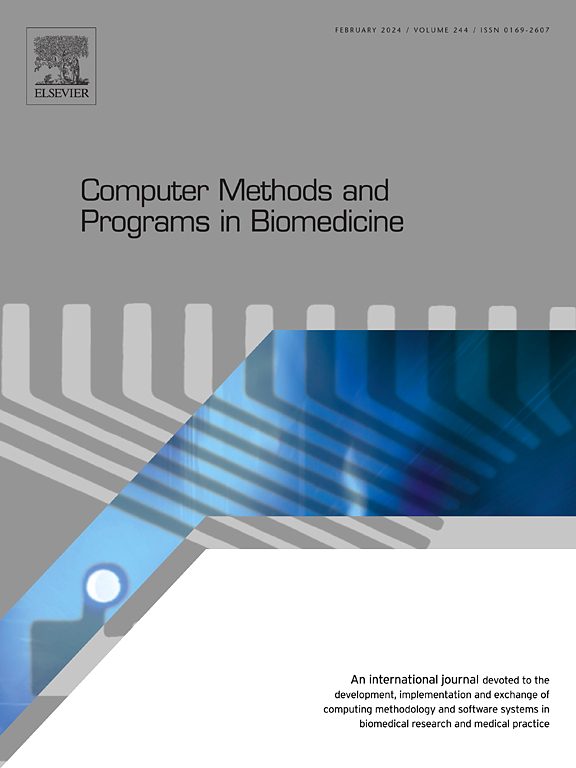The knowledge distillation-assisted multimodal model for osteoporosis screening
IF 4.8
2区 医学
Q1 COMPUTER SCIENCE, INTERDISCIPLINARY APPLICATIONS
引用次数: 0
Abstract
Background and objective
Osteoporosis is characterized by reduced bone mass and deterioration of bone structure, yet screening rates prior to fractures remain low. Given its high prevalence and severe consequences, developing an effective osteoporosis screening model is highly significant. However, constructing these screening models presents two main challenges. First, selecting representative slices from CT image sequences is challenging, making it crucial to filter the most indicative slices. Second, samples lacking complete modal data cannot be directly used in multimodal fusion, resulting in underutilization of available data and limiting the performance of the multimodal osteoporosis screening model.
Methods
In this paper, we propose a reinforcement learning-driven knowledge distillation-assisted multimodal model for osteoporosis screening. The model integrates demographic characteristics, routine laboratory indicators, and CT images. Specifically, our framework includes two novel components: 1) a deep reinforcement learning-based image selection module (DRLIS) designed to select representative image slices from CT sequences; and 2) a knowledge distillation-assisted multimodal model (KDAMM) that transfers information from single-modal teacher networks to the multimodal model, effectively utilizing samples with incomplete modalities. The codes are published on: https://github.com/AImedcinesdu212/Osteoporosis-Predictionhttps://github.com/Hidden-neurosis/osreoporosis.git.
Results
The proposed multimodal osteoporosis screening model achieves an accuracy of 88.65 % and an AUC of 0.9542, surpassing existing models by 2.85 % in accuracy and 0.0212 in AUC. Additionally, we demonstrate the effectiveness of each novelty within our framework. The SHAP values are calculated to assess the importance of demographic characteristics and routine laboratory test data.
Conclusion
This paper presents a knowledge distillation-assisted multimodal model for opportunistic osteoporosis screening. The model incorporates demographic characteristics, routine laboratory indicators (including blood tests and urinalysis), and CT images. Extensive experiments, conducted on self-collected datasets, validate that the proposed framework achieves state-of-the-art performance.

知识提炼辅助骨质疏松筛查的多模态模型
背景与目的骨质疏松症以骨量减少和骨结构恶化为特征,但骨折前的筛查率仍然很低。鉴于其高患病率和严重后果,开发一种有效的骨质疏松症筛查模型是非常重要的。然而,构建这些筛选模型面临两个主要挑战。首先,从CT图像序列中选择具有代表性的切片具有挑战性,因此过滤最具指示性的切片至关重要。其次,缺乏完整模态数据的样本不能直接用于多模态融合,导致现有数据利用不足,限制了多模态骨质疏松筛查模型的性能。方法提出一种强化学习驱动的知识提取辅助骨质疏松筛查多模态模型。该模型集成了人口统计学特征、常规实验室指标和CT图像。具体来说,我们的框架包括两个新组件:1)基于深度强化学习的图像选择模块(DRLIS),用于从CT序列中选择具有代表性的图像切片;2)知识提取辅助多模态模型(KDAMM),将信息从单模态教师网络转移到多模态模型,有效利用不完全模态的样本。本文提出的多模态骨质疏松筛查模型的准确率为88.65%,AUC为0.9542,比现有模型的准确率和AUC分别高出2.85%和0.0212。此外,我们在我们的框架中展示了每个新事物的有效性。SHAP值的计算是为了评估人口统计学特征和常规实验室测试数据的重要性。结论提出了一种知识提取辅助的多模态骨质疏松筛查模型。该模型结合了人口统计学特征、常规实验室指标(包括血液检查和尿液分析)和CT图像。在自行收集的数据集上进行的大量实验验证了所提出的框架达到了最先进的性能。
本文章由计算机程序翻译,如有差异,请以英文原文为准。
求助全文
约1分钟内获得全文
求助全文
来源期刊

Computer methods and programs in biomedicine
工程技术-工程:生物医学
CiteScore
12.30
自引率
6.60%
发文量
601
审稿时长
135 days
期刊介绍:
To encourage the development of formal computing methods, and their application in biomedical research and medical practice, by illustration of fundamental principles in biomedical informatics research; to stimulate basic research into application software design; to report the state of research of biomedical information processing projects; to report new computer methodologies applied in biomedical areas; the eventual distribution of demonstrable software to avoid duplication of effort; to provide a forum for discussion and improvement of existing software; to optimize contact between national organizations and regional user groups by promoting an international exchange of information on formal methods, standards and software in biomedicine.
Computer Methods and Programs in Biomedicine covers computing methodology and software systems derived from computing science for implementation in all aspects of biomedical research and medical practice. It is designed to serve: biochemists; biologists; geneticists; immunologists; neuroscientists; pharmacologists; toxicologists; clinicians; epidemiologists; psychiatrists; psychologists; cardiologists; chemists; (radio)physicists; computer scientists; programmers and systems analysts; biomedical, clinical, electrical and other engineers; teachers of medical informatics and users of educational software.
 求助内容:
求助内容: 应助结果提醒方式:
应助结果提醒方式:


